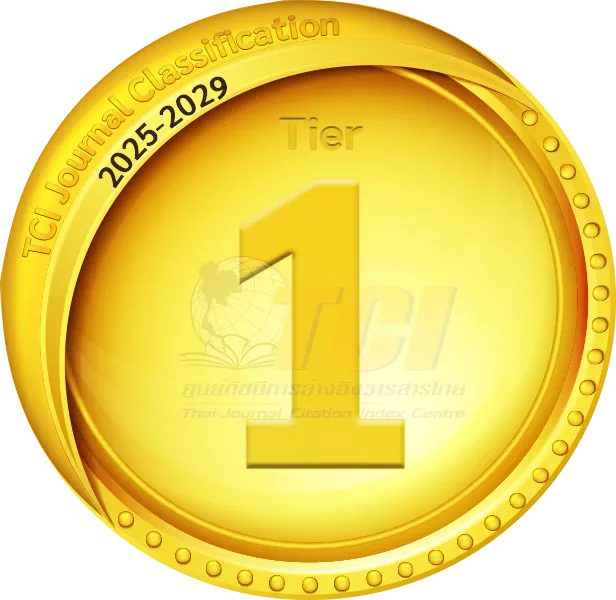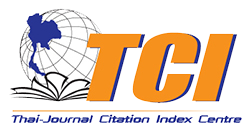การพัฒนาเซรั่มผสมสารสกัดจากเปลือกผลไม้ที่มีฤทธิ์ยับยั้งเชื้อแบคทีเรียก่อโรคผิวหนัง
Serum Development of Fruit Peel Extracts Against Skin Pathogenic Bacteria
Abstract
ปัจจุบันผลิตภัณฑ์เซรั่มมีคุณสมบัติในการเพิ่มความชุ่มชื้นแก่ผิวหนัง อย่างไรก็ตามการพิจารณาประสิทธิภาพในการยับยั้งการเจริญเติบโตของจุลินทรีย์ที่ก่อให้เกิดโรคผิวหนังเป็นปัจจัยสำคัญที่ช่วยเพิ่มคุณค่าทางการใช้งานของผลิตภัณฑ์ดังกล่าว งานวิจัยนี้มีวัตถุประสงค์เพื่อพัฒนาเซรั่มที่มีฤทธิ์ต้านแบคทีเรียก่อโรคผิวหนัง โดยใช้สารสกัดจากเปลือกผลไม้ไทย 5 ชนิด ได้แก่ ทับทิม ทุเรียน ส้มโอ มังคุด และกล้วย ในการศึกษาความสามารถในการยับยั้งแบคทีเรียสายพันธุ์ Escherichia coli, Pseudomonas aeruginosa, Salmonella typhimurium, Staphylococcus aureus และ Staphylococcus epidermidis โดยทำการสกัดสารออกฤทธิ์ 2 วิธี ได้แก่ การสกัดด้วยน้ำและการสกัดด้วยเอทานอล 95% ผลการทดลองพบว่าเซรั่มที่มีส่วนผสมของสารสกัดเปลือกทับทิม ร้อยละ 1 สามารถยับยั้งการเจริญเติบโตของแบคทีเรียได้อย่างมีประสิทธิภาพมากที่สุด การประเมินความชอบพบว่าเซรั่มที่ผสมสารสกัดจากเปลือกทับทิมได้รับความนิยมสูงสุดในกลุ่มผู้เข้าร่วมการทดสอบ ดังนั้นสารสกัดจากเปลือกทับทิมจึงมีศักยภาพในการนำไปพัฒนาเป็นสารออกฤทธิ์หลักในผลิตภัณฑ์เซรั่ม เพื่อสุขอนามัยผิวหนังและอาจเป็นทางเลือกที่มีความปลอดภัยและยั่งยืนสำหรับการควบคุมการติดเชื้อจากจุลินทรีย์บนผิวหนังในอนาคต
Currently, serum products are widely recognized for their moisturizing properties. However, consideration of their antimicrobial efficacy against skin pathogens is also important to enhance the functional value of these products. This study aimed to develop serum products with antibacterial activity against common skin pathogens. The extracts in this study were obtained from the peels of five Thai fruits: pomegranate, durian, pomelo, mangosteen, and banana. The bacterial strains tested included Escherichia coli, Pseudomonas aeruginosa, Salmonella typhimurium, Staphylococcus aureus, and Staphylococcus epidermidis. The antibacterial activity of each extract and serum was evaluated. Two extraction methods were used: aqueous extraction and 95% ethanol extraction. The results showed that the serum containing 1% pomegranate peel extract exhibited the strongest antibacterial activity. Furthermore, the preference test revealed that most participants favored the serum containing pomegranate peel extract. Therefore, pomegranate peel extract may serve as a potential antibacterial ingredient in skincare serum products, contributing to improved skin hygiene and providing a safe and sustainable option for controlling microbial infections on the skin in the future.
Keywords
[1] J. Jeong, J. Y. Lee, S. H. Lee, A. Lee, and J. Hong, “Trends in bacterial skin infections and their antibiotic susceptibility in Korea: A 13-year single-center study,” Journal of Mycology and Infection, vol. 25, no. 3, pp. 51–56, Oct. 2020.
[2] M. M. Severn and A. R. Horswill, “Staphylococcus epidermidis and its dual lifestyle in skin health and infection,” Nature Reviews Microbiology, vol. 21, pp. 97–111, Feb. 2023.
[3] D. L. Stulberg, M. A. Penrod, and R. Blatný, “Common bacterial skin infections,” American Family Physician, vol. 66, no. 1, pp. 119–125, Jul. 2002.
[4] N. Spernovasilis, M. Psichogiou, and G. Poulakou, “Skin manifestations of Pseudomonas aeruginosa infections,” Current Opinion in Infectious Diseases, vol. 34, no. 2, pp. 72–79, Apr. 2021.
[5] A. Ranjan, S. Shaik, N. Nandanwar, A. Hussain, S. K. Tiwari, T. Semmler, S. Jadhav, L. H. Wieler, M. Alam, R. R. Colwell, and N. Ahmed, “Comparative genomics of Escherichia coli isolated from skin and soft tissue and other extraintestinal infections,” mBio, vol. 8, pp. 1–10, Aug. 2017.
[6] R. E. Othman, F. Allaw, A. Kharsa, and S. Hallit, “Salmonella typhimurium necrotizing fasciitis: A case report,” Journal of Medical Case Reports, vol. 17, pp. 345, Aug. 2023.
[7] S. Budiasih, I. Masyitah, K. Jiyauddin, M. Kaleemullah, A. D. Samer, A. M. Fadli, and E. Yusuf, “Formulation and characterization of cosmetic serum containing argan oil as moisturizing agent,” in Proceedings of BROMO Conference (BROMO 2018), Symposium on Natural Product and Biodiversity, 2018, pp. 1–8.
[8] Z. D. Draelos, I. Díaz, J. Namkoong, J. Wu, and T. Boyd, “Efficacy evaluation of a topical hyaluronic acid serum in facial photoaging,” Dermatology and Therapy, vol. 11, no.4, pp. 1385–1394, Jun. 2021.
[9] W. P. Werschler, N. S. Trookman, R. L. Rizer, E. T. Ho, and R. C. Mehta, “Enhanced efficacy of a facial hydrating serum in subjects with normal or self-perceived dry skin,” Journal of Clinical and Aesthetic Dermatology, vol. 4, no. 2, pp. 51–55, Feb. 2011.
[10] F. Iulia-Burra, E. O. Martínez, M. A. R. Martínez, and M. E. M. Hernández, “Design and development of a facial serum with Lactobacillus fermentum CECT 5716,” Ars Pharmaceutica (Internet), vol. 64, no. 3, pp. 230–242, Jun. 2023.
[11] S. Rawal and S. A. Ali, “Probiotics and postbiotics play a role in maintaining dermal health,” Food Function, vol. 14, pp. 3966–3981, Mar. 2023.
[12] I. Negut, V. Grumezescu, and A. M. Grumezescu, “Treatment strategies for infected wounds,” Molecules, vol. 23, no. 9, pp. 1–23, Sep. 2018.
[13] C. V. De Almeida, E. Antiga, and M. Lulli, “Oral and topical probiotics and postbiotics in skincare and dermatological therapy: A concise review,” Microorganisms, vol. 11, no. 6, pp. 1–17, May 2023.
[14] D. A. Williamson, G. P. Carter, and B. P. Howden, “Current and emerging topical antibacterials and antiseptics: Agents, action, and resistance patterns,” Clinical Microbiology Reviews, vol. 30, no. 3, pp. 827–860, Jul. 2017.
[15] S. Malviya, A. Arvind, A. Jha, and N. S. Hettiarachchy, “Antioxidant and antibacterial potentialof pomegranate peel extracts,” Journal of Food Science and Technology, vol. 51, pp. 4132–4137, Dec. 2014.
[16] S. Devatkal, P. Jaiswal, S. N. Jha, R. K. Bharadwaj, and K. N. Viswas, “Antibacterial activity of aqueous extract of pomegranate peel against Pseudomonas stutzeri isolated from poultry meat,” Journal of Food Science and Technology, vol. 50, pp. 555–560, Jun. 2013.
[17] S. Aichayawanich and C. Ngaowthong, “Antimicrobial activity of crude extract from pomelo peel against Staphylococcus aureus,” Advanced Materials Research, vol. 550–553, pp. 1871–1874, Jul. 2012.
[18] A. W. Indrianingsih, V. T. Rosyida, D. Ratih, and Batrisya, “In vitro study of antioxidant and antimicrobial activities of Garcinia mangostana L. peel extract,” in Proceedings of the 5th International Conference on Food, Agriculture and Natural Resources (FANRes 2019), 2020, pp. 152–155.
[19] I. O. Mohammed, A. A. Alrasheid, and S. M. H. Ayoub, “GC-MS analysis and study of the antimicrobial activity of Citrus paradisi, Citrus aurantifolia, and Citrus sinensis peel essential oils as hand sanitizer,” International Journal of Microbiology, vol. 2024, pp. 1–11, Jan. 2024.
[20] E. Octiara, C. P. Meliala, and L. Sikumbang, “Antibacterial activity of durian peel ethanol extract (Durio zibethinus Murr.) against Streptococcus mutans and Enterococcus faecalis,” Biomedical and Pharmacology Journal, Jun. 2023.
[21] S. P. Kapadia, P. S. Pudakalkatti, and S. S. Shivanaikar, “Detection of antimicrobial activity of banana peel (Musa paradisiaca L.) on Porphyromonas gingivalis and Aggregatibacter actinomycetemcomitans: An in vitro study,” Contemporary Clinical Dentistry, vol. 6, pp. 496–499, Oct. 2015.
[22] T. Chaiwarit, N. Kantrong, S. R. Sommano, P. Rachtanapun, T. Junmahasathien, M. Kumpugdee-Vollrath, and P. Jantrawut, “Extraction of tropical fruit peels and development of HPMC film containing the extracts as an active antibacterial packaging material,” Molecules, vol. 26, no. 8, pp. 1–16, Apr. 2021.
[23] T. Theerawongkanjana, S. Kraisuwan, and W. Tamthong, “The effects of banana peel from different varieties on tannin content and antibacterial activity on cotton fabrics,” in Proceedings the 14th Hatyai National and International Conference, 2023, pp. 581–593.
[24] S. S. Dixit, L. Muruganandam, and I. G. Moorthy, “Pectin from fruit peel: A comprehensive review on various extraction approaches and their potential applications in pharmaceutical and food industries,” Carbohydrate Polymer Technologies and Applications, vol. 9, pp. 1–26, Mar. 2025.
[25] AOAC, Determination of Moisture, Ash, Protein and Fat. Official Method of Analysis of the Association of Analytical Chemists, 18th ed., Washington, DC, 2005.
[26] P. Intarakasem, S. Nualkaew, and T. Padumanonda, “Validation of rutin analysis in cassava (Manihot esculenta) leaves using TLC-densitometer,” in Proceedings The International Conference onHerbal and Traditional Medicine (HTM 2015), Khonkaen, Thailand, 2015, pp. 160–166.
[27] R. Saxena, R. Sharma, and B. C. Nandy, “ Chromatographic determination of phenolic profile from Punica granatum fruit peels,” International Research Journal of Pharmacy, vol. 8, no. 1, pp. 61–65, Feb. 2017.
[28] D. Rizaldy, N. K. Ramadhita, T. Nadhifa, and I. Fidrianny, “Mangosteen (Garcinia mangostana L.): Evaluation of in vitro antioxidant activities,” Pharmacognosy Journal, vol. 14, no. 3, pp. 633–640, May 2022.
DOI: 10.14416/j.kmutnb.2025.11.001
ISSN: 2985-2145





